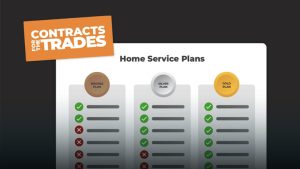When it comes to contractor business management, sales and marketing teams don’t always see eye-to-eye.
Most of these issues arise from the fact that contractor businesses usually develop organically, starting out small and then grow in a reactive manner, which means hiring someone when it’s deemed necessary, rather than anticipating a potential need.
This is an excellent way to run a tight ship and for many owners, it’s a recipe for success and efficiency. But once you’re in a position to invest in both a sales and a marketing strategy, things start to become more challenging.
However, flipping the script and thinking about sales and marketing not as two different strategies, but one overarching narrative that communicates your business ethos to your customer, is what smartketing is all about.
Let’s break it down!

What is smarketing for a contractor business?
Simply put, a smarketing strategy brings together the sales and marketing departments of a contractor business by setting common performance parameters and goals.
If you haven’t updated your email templates for some time, an easy goal would be to have a look at this communication toolkit and get started!
Why is it useful to have a smarketing strategy as a contractor?
When sales and marketing don’t work closely together, it’s easy for both to lose track of the actual impact they’re making on a business. This is how vanity metrics develop, where some numbers might look good at the end of a quarter, but they don’t have any real ROI.
For example, the sales team can easily lose track of the effort that goes into raising awareness and turning that awareness into qualified leads. Marketing as well can lose sight of what is the real impact of the leads they’ve generated and whether they were worth the effort of converting in the first place.
In the end, a cycle is generated, where sales blames marketing for not bringing in enough leads, while marketing blames sales for not converting those they did connect with.
A smarketing strategy solves this issue by making lead generation and qualification as well as conversion, everyone’s responsibility.
How smarketing can help your contractor business drive revenue
1. Make the most out of your communications
Every email is an opportunity for your smarketing team to prove its worth, by helping you sell to more people and spread awareness of your services. And we don’t just mean newsletters and sales emails; if your invoice doesn’t have your company logo on it, that’s a wasted opportunity. So is asking people for reviews with a 5-word email, then expecting them to actually give you any feedback.
If this all sounds backwards to you, that’s because we live in a customer-obsessed world (Amazon coined this phrase as their motto). Doing a good plumbing job or fixing up a difficult HVAC install simply isn’t enough anymore. If you want to stand out from the competition, you need to step up your game and look into every detail.
Looking for more articles about service business marketing? Check out the full category here!
Start by writing down every type of email you send out to customers, whether that’s booking confirmations, property access requests, or any other communication, no matter how small. Then consider if they’re the kind of messages that are easy for you to write and make sense to a contractor or if they’re something a customer would be impressed by and find useful.
Consider the difference between: “Leave a review here.” and “Your feedback is important to us, as we always seek to improve our services, so you’ll be doing us a great favor by leaving a review here.”
Both versions say the same thing, but it’s pretty obvious which one will be more effective, right? This is the kind of flair for customer service that a marketing strategy can and should embed in all your customer communications.
2. Helping to guide leads through the buying process
The basic smarketing step-by-step happens when marketing gets visitors to come onto your website (perhaps through an excellent article that ranks well on Google) and they convert via a gated piece of content (e.g. they share their contact details in exchange for a proposal template).
Then, the sales team gets notified of this new contact and the information gathered about them by marketing (i.e. the pages they visited, which content helped to capture their information, the data they provided). From there, they can put together an email workflow that makes the qualified lead feel acknowledged and creates a brand association in their minds. The best way to manage, store, and use this data is via a CRM (like HubSpot) that integrates with your job management software.
If this doesn’t sound like your usual contractor business management strategy, it’s because not enough people think of it that way and there’s a definite lack of content out there that’s targeting niche industries with forward-thinking ideas.
Your current contractor business management strategy might have marketing creating content for a blog or a video series, put up ads on social media, or in print, while sales is busy cold calling. At no point do their activities overlap.
Now, imagine if marketing could provide the contact information coupled with details about a lead (e.g. a restaurant chain owner looking to do appliance maintenance & electrical work for 15 locations; budget $500 000) to one of your sales reps, who would then contact the lead with a hyper-personalized pitch. That’s how smarketing optimizes your lead conversion process, significantly increasing the chances of landing a customer.
3. Marketing and sales are not in competition, they’re in symbiosis
In order for the example above to work, marketing and sales have to communicate and do it well, but to achieve that, they cannot exist in a state of competition.
Smarketing means symbiosis and a great contractor business management strategy can achieve that by setting common parameters in what’s known as an internal service level agreement (or SLA, something you might be familiar with if you’ve done work in the commercial sector).
This service level agreement binds the two teams with common responsibilities, but also helps them share in the successes they achieve. For example, the marketing team can commit to:
- Bring in X amount of traffic/month to the website
- Bring in X number of leads/month
At the same time, the sales team can commit to:
- Contact each marketing qualified lead within a certain amount of time
- Communicate objections they’ve encountered each month
Of course, there are many other activities both teams can commit to, but by creating a narrative between them, each member can feel more in control of the outcome and have ownership over team successes.
4. Make customer journeys the goal of your smarketing strategy
Identifying the core elements of a smarketing strategy can be challenging for a contractor business manager or owner, unless they start with their customer journeys. And we do mean journeys, plural.
According to Customer Think, “the complete sum of interactions between a customer and a field service business is not singular; their experience is made up of many interactions that require individual attention”.
In the field service industry, where contractors operate, breaking down the final experience into individual journeys—or touch-points—can make it much easier to identify where marketing and sales should intervene in order to smooth out any friction.
In our complete guide on field service customer journeys mapping, we break it down like this: “individual interactions (that can be grouped) that a customer has with your business. It could be when they book a job, accept a proposal/quote, send a review, receive an invoice, or become a repeat customer.”
An easy example would be singling out the quoting process. If a sales rep finds that most prospects drop out after the first call, perhaps it’s time to consider a better proposal? Marketing can help in this area by providing visual expertise and copywriting, while sales experts can assign the correct proposal to the right prospect.
The takeaway on contractor business management and smarketing
All in all, bringing together sales and marketing can seem like a daunting task for contractor businesses, especially if you don’t have the capacity for full departments yet. This being said, it’s important to lay down a solid foundation, even if, for now, it’s just you doing both, whilst juggling dozens of other tasks.
Good sales and marketing practices pave the way for long-term success and will ensure your business continues to grow sustainably. If you just want to dip your toes, check out our complete field service marketing guide below to help your marketing strategy stay relevant and up-to-date. It costs nothing and, chances are, your business website will rank higher on Google and stand to get quicker results.

Cristina Maria
I'm here to bring you next-level strategies to the field service industry. When I'm not working on the best tips to grow your business, I'm on the lookout for sci-fi novels and cookie recipes.












